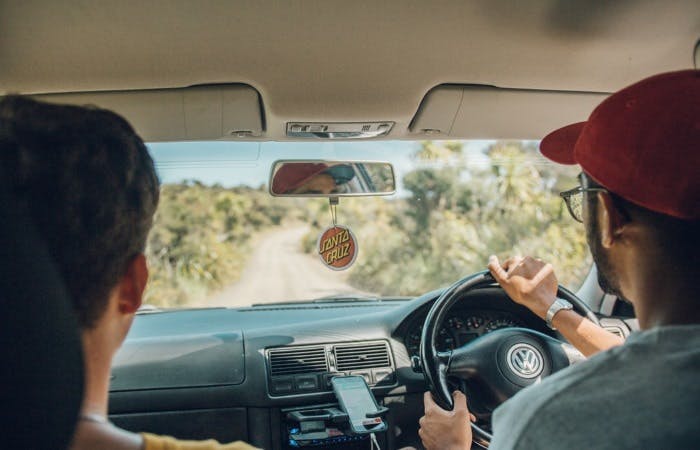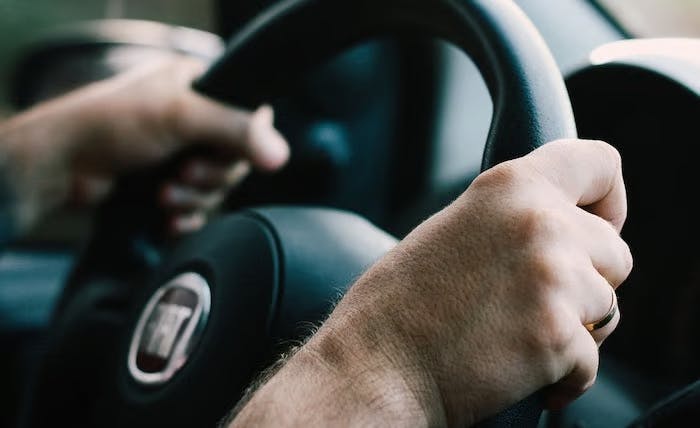Being in control of a vehicle can seem pretty scary, especially if you're a new or inexperienced driver. It's easy to let the nerves creep in. But don't lose hope: there are actually two key ways in which you can become a confident driver. The first is to become a better, more skilful driver. The second is to take control of the things you can, to remain calm in the face of the things you can’t.
Under these two headings, we've expanded on 11 practical tips to help you ditch the anxiety and increase your confidence behind the wheel.
Become a confident driver by becoming a better driver
The best way to increase your confidence is to up your skill level. Loads of drivers lack confidence because they aren’t totally sure of what they’re doing on the roads. As you start learning to drive, there might be lots of situations that faze you, but as you progress, these will become less common. However, even experienced drivers can find themselves worrying about having to perform certain manoeuvres, or coming across a scenario where they aren’t 100% certain about what to do.
The good news is that this is absolutely fixable! But be prepared: it’s going to take some work. Don’t listen to anyone who pretends there’s a quick fix or a secret ‘hack’ that’ll automatically make you a great driver. The key is practice—and lots of it. In order to practice effectively, you need to know what, exactly, you need to work on.
Identify what makes you anxious as a driver

Try to work out if there’s a particular trigger that affects your confidence when driving. Here are some ideas to help you narrow it down—you might experience one of them, or all of them.
Fear of:
- Going wrong
- Overtaking or driving at speed
- Busy junctions
- Driving alone
- Performing a specific manoeuvre
- Driving at night
Identifying your concerns will help to focus your practice. But before you get in the car, check that you know the rules properly—especially if it’s been a while since you revised for your theory test.
Know the rules inside out
While there’s no shortcut to advancing your actual practical skills, you can help the process along by getting familiar with your driving theory. This will help you become a more confident driver because:
✓ You will know what’s allowed—and what isn’t—so you won’t have to worry about being unsure of the rules in any given situation, so that
✓ When you’re out and about, you can keep your focus on improving your practical skills.
If you’re not sure what sort of things we mean by theory skills and practical skills, here are some examples.
Theory skills tend to be about the rules of the road, and include:
- Road signs and signals (including filter lights and police hand signals)
- Road markings (including box junction rules and pedestrian crossings)
- Right of way rules (at all kinds of junctions)
Practical skills require you to physically do something when driving, and include:
There’s a lot of overlap between theory and practical, because there are rules governing pretty much every action you take on the roads. So, if you’re confident in your theory, you’re halfway there already.
Stay safe
There’s a line between being a safe driver and being overly cautious. When you’re starting out, or if you’re a naturally nervous driver, you might feel averse to any type of risk—but being a confident driver isn't about becoming reckless. It just means you’re able to evaluate and respond to risks properly.
The key to gaining confidence while remaining careful and in control is being really hot on your hazard perception. You can practice this skill when you’re out and about, going down the street or sitting as a passenger in a vehicle.
- Look ahead—as far forward as you can without deviating from your ‘lane’
- As the landscape changes in front of you, spot anything that has the potential to affect your path
- Think about how you would react to this change if you were driving. You might check your mirrors, slow down, or just keeping an eye on the situation to see whether it develops further
Use your driving lessons effectively (to become a confident learner driver)
The best place to address your confidence issues are during your driving lessons. Once you pass your test, you’ll no longer be able to rely on your instructor to talk you out of stressful situations. You’re in a unique position during lessons: there’s a professional sitting right beside you. It’s their job to teach you, answer your questions and give you tips—so use them. If you let embarrassment stop you from asking how to do something for what feels like the 100th time, you’re just letting a valuable opportunity slide away from you. It is, literally, what you’re paying for.
It doesn’t matter if it’s an ‘easy’ skill or one they taught you right at the beginning of your lessons. If you feel like you’re winging it, ask them to go right back to the beginning, and teach you that technique again from scratch. Get the hang of it properly, and you'll become a much more confident driver.
Get the most out of your driving lessons by:
✓ Asking any questions that come to mind
✓ Telling your instructor which areas you don’t feel confident in
✓ Keeping a diary of your lessons, and referring back to it at intervals to see the progress you’ve made
Practice on your own

If you’re already a qualified driver, but feel that you struggle with confidence because you need reassurance or help doing a particular manoeuvre or skill, then there are a few things you can do.
- Look up guides online. Depending on your preferred learning technique, you might pick things up better from a YouTube video, or from a written step-by-step guide.
- Don’t avoid driving. Instead of ignoring the problem, give yourself a safe space to practice your skills. Go somewhere quiet, like a car park or industrial estate, to work on manoeuvres.
- Pop a ‘P’ plate on your car. This will help if you’re feeling self-conscious, as it will make other drivers around you aware that you need some space.
- Take some refresher lessons. Ask your instructor to focus on helping you with anything you find particularly challenging.
Build your confidence by pushing out of your comfort zone (a bit at a time)
Fear of the unknown hurts many drivers’ confidence. Any manner of unexpected things can occur on a journey. But once you accept that you aren’t always going to get in the right lane, or go the right direction, or find a spot where you want to park, then you can learn how to stop that fear having any power over you. Truly confident drivers adapt to unknown situations without panicking.
In order to get to this point, it’s crucial to push yourself—but only gradually. Going too far outside your comfort zone just sets you up to fail, which in turn is likely to make you feel less confident. Here are some challenges that can help you deal with unexpected situations and build your confidence in a sustainable way.
Challenge 1: Tally your surroundings with your sat nav.
Some people will be asked to demonstrate their ability to drive using road signs during the practical test, so it should be something your instructor teaches you during your lessons. However, many drivers still feel more confident when using an electronic map. That’s absolutely fine, but occasionally technology will fail you. There’s nothing more panic-inducing than having your phone tell you it’s rerouting, just as you come up to a junction.
Build your confidence by trying to reconcile your surroundings with what your sat nav is telling you. For instance, if it says to get in the left hand lane for the next roundabout, see if there’s a direction sign or road marking that indicates the same thing. Gradually you’ll find you're able to drive on your own, rather than following your phone.
Challenge 2: Practice driving to different destinations within a familiar area.
If you’ve passed your test, take someone who knows the roads with you as a passenger. Their calm presence will help to reassure you, even if you go wrong. An extra pair of eyes always helps.
Challenge 3: Drive alone at different times of the day and night — but stick to routes you're familiar with.
This will give you practice driving in an array of weather, light and traffic conditions, but keep you within your comfort zone in other ways. Once you’re confident in this, try going a little further afield.
Challenge 4: Park somewhere new.
Your favourite car park might not always be available. Try driving to somewhere you know, but finding different places to park each time. Eventually you’ll get used to navigating unfamiliar roads while calmly scouting for a space—a skill you can transfer to other destinations.
Become a confident driver by taking control where you can

There’s always going to be a degree of pressure when driving, so instead of worrying about the things you can’t control, do what you can to preempt and prevent avoidable stress.
Give yourself time to prepare
Stress builds stress, and that’s the last thing you want on the roads. So try to make sure to always leave enough time for your journey, and give yourself a bit of time beforehand to make sure that you:
✓ Wear appropriate clothing. Ideally, you should drive in shoes with flat soles so you can feel the pedals. It’s also wise to make sure you’re not wearing anything too warm. If you’re feeling nervous, you’re likely to start sweating. Take layers with you, and use the temperature controls in the car to regulate your body temperature as you drive.
✓ Plan your route. Getting lost—or fearing getting lost—can rattle your nerves. Take the time to look at your route ahead of time. That includes checking out where you want to park—and ideally a backup option, in case the first is unavailable on the day.
✓ Set up your phone or sat nav. Relying on your phone for a map app? Make sure it’s charged. Take the time to input your destination and set your device to the right volume before you start the car.
Take your time
Something that can plague new, or unconfident drivers, is the fear of holding people up. It’s especially an issue if you need to perform a manoeuvre, or if you make a mistake, like stalling.
First things first: you are going to hold people up. There, we said it. There’s not a lot you can do about it. If people can get past you safely, they will… and if they can’t, well, that’s just part of driving. Sometimes you’ll have to sit there while someone else parallel parks and sometimes they’ll have to wait for you.
Remember:
✓ Take your time. It’s much better to go slowly and do something right than to rush and make a mistake. That way you’ll be in a much calmer state of mind and have a more positive journey.
✓ Most people are nice. Rude drivers seem to be everywhere. But they only stick out in our minds because their behaviour is out of the norm!
✓ You have as much right to be on the roads as everyone else. You wouldn’t deny others the right to take their time, so try not to get intimidated by them waiting on you.
Limit distractions
If you don’t feel confident taking a whole car-full of passengers with you straight away, then don’t. This is something you can build up to, starting with one or two passengers who you can trust to remain calm and quiet when you need them to be.
In the same vein, once you become a more confident driver, you’ll be able to have music blaring away. There’s plenty of time for that, so know your boundaries, and if you’re struggling to concentrate, keep things quiet.
Keep calm with breathing exercises
A calm driver creates a confident driver. Nerves manifest themselves physically: your heart beats faster; you might get sweaty palms or start to shake. To an extent, heightened awareness, and appreciation of the risks of driving, can be a good thing. But these physical symptoms of stress can also negatively impact your ability to drive safely. Certain breathing techniques can help to lower your heart rate and keep on top of your nerves.
Breathing Exercise (as recommended by the NHS)
- Let your breath flow as deep down into your belly as is comfortable, without forcing it.
- Try breathing in through your nose and out through your mouth.
- Breathe in gently and regularly. Some people find it helpful to count steadily from 1 to 5. You may not be able to reach 5 at first.
- Then, without pausing or holding your breath, let it flow out gently, counting from 1 to 5 again, if you find this helpful.
- Keep doing this for 3 to 5 minutes.
Source: NHS
If you’ve never done breathing exercises before, you’re unlikely to be able to do them effectively when you’re in a situation where you need them. Practice them regularly when you aren’t driving, so that you can call them to mind when you need to.
Rule out any other factors impacting your confidence in driving
When working out what’s causing you to feel anxious behind the wheel, check that you’re in tip-top condition to drive. By removing factors like poor eyesight or fatigue from the equation, you can ensure that you can become the confident driver you were always destined to be.
Eyesight
You might not realise that you’re compensating for poor eyesight, but make sure your confidence isn’t being impeded by poor vision. It’s recommended that most adults get an eye test every two years, but many people don’t do this. Headaches, squinting to focus on things, or blurred vision are all signs you might need corrective eyewear when you’re driving.
Tiredness
If you drive when you’re tired, it’s much easier to let worries overwhelm you. Not only will rest help you to put your fears and anxieties into perspective, it’ll also help you to drive more safely, so your level of risk is also reduced.
Just as you might if you’ve had a break from driving, if you’re struggling for confidence, you'll probably benefit from a few refresher driving lessons. Before booking, explain to your instructor that you want to become more confident as a driver—and tell them the things that make you particularly anxious. They can then help you to practice these skills in a safe environment.
And keep in mind that mistakes are a normal part of driving. Here's how to deal with them.
Subscribe for driving advice, offers & more
We'd love to let you know about our courses, news and offers via email. You may unsubscribe at any time.
Star Genie Limited trading as PassMeFast. Company number 10093359
Copyright © 2024 owned by Star Genie Limited
PassMeFast, Blue Tower, MediaCityUK, Salford, M50 2ST
